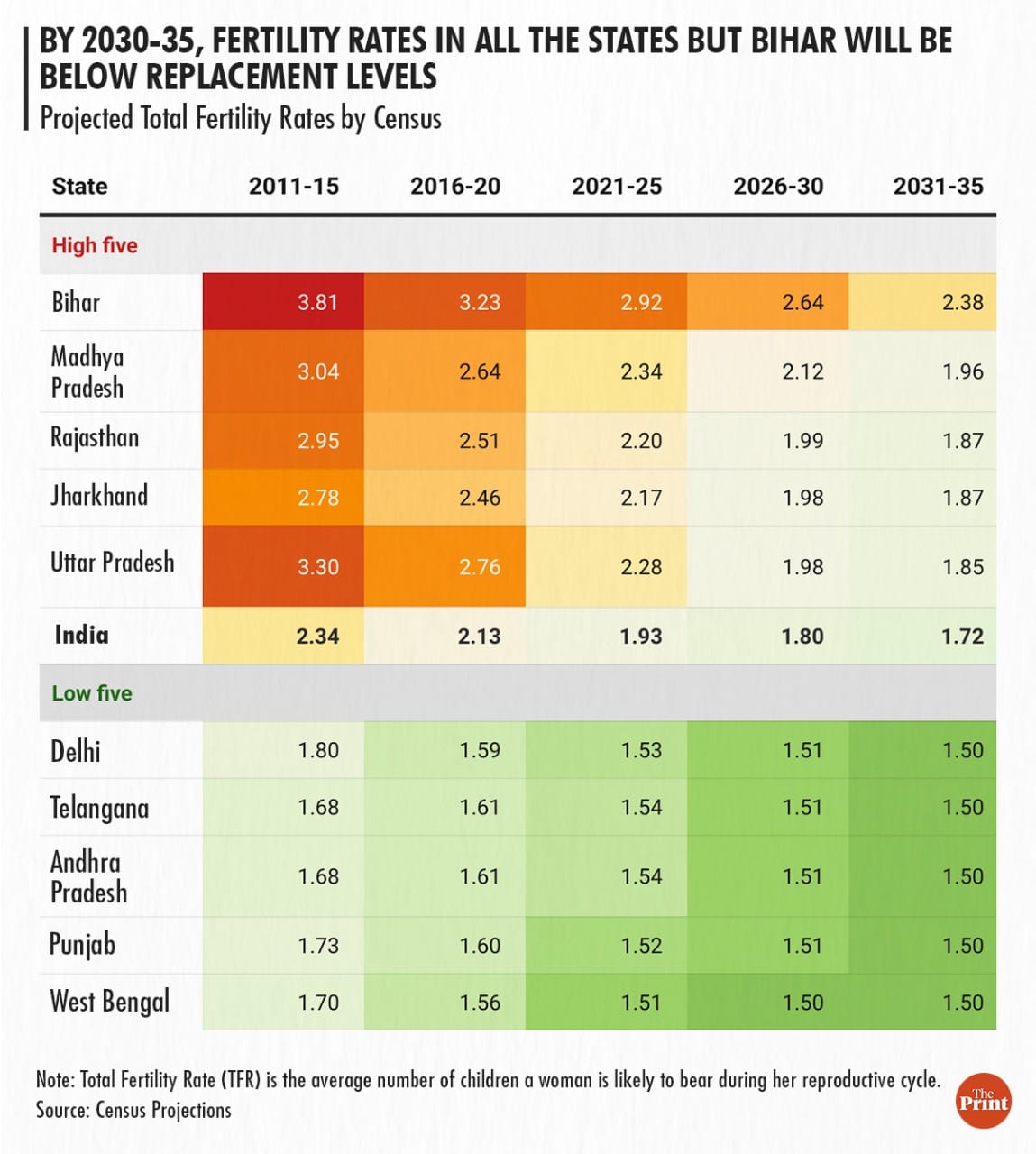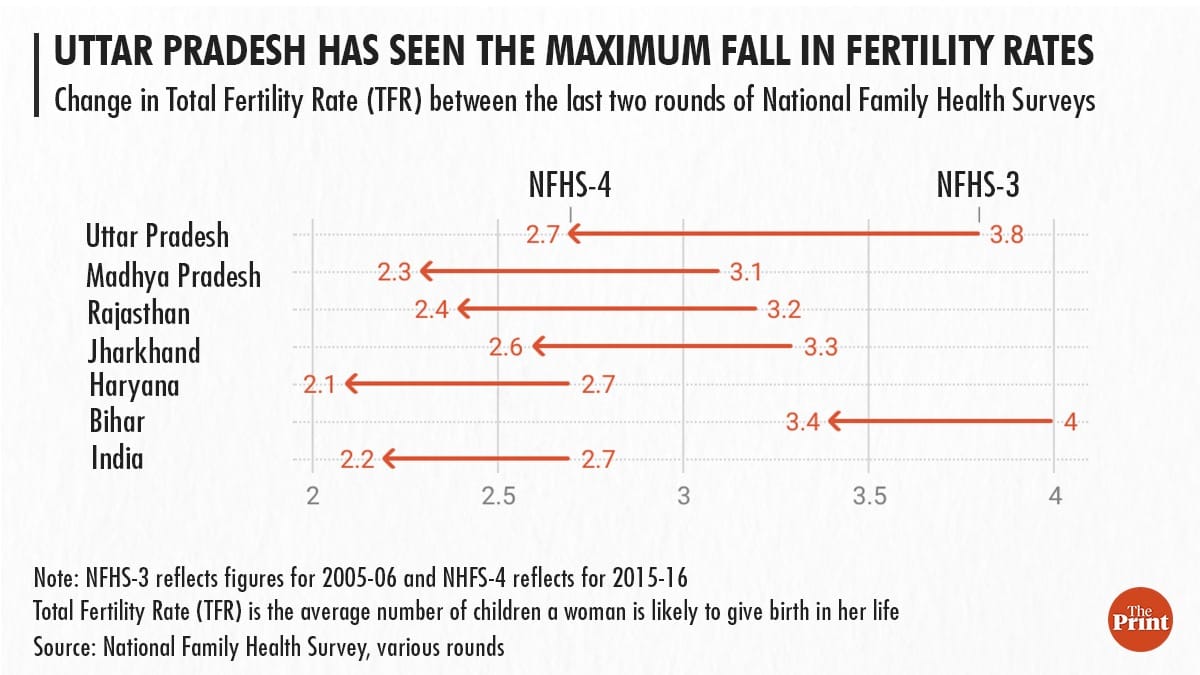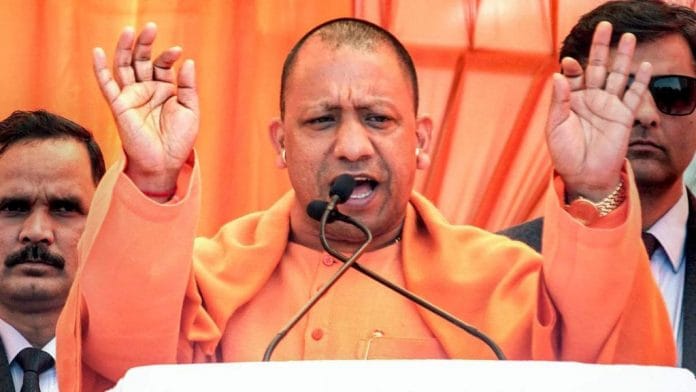New Delhi: The Uttar Pradesh draft population control bill has sparked controversy over provisions that while promoting a two-child policy, bars violators from contesting local body elections, government jobs and all forms of subsidy.
While opposition leaders have called the bill election propaganda by the BJP, the Yogi Adityanath government has said that with the Uttar Pradesh Population (Control, Stabilization and Welfare) Bill, 2021, and the Population Policy 2021-30, it hopes to bring down the total fertility rate (TFR) in the state to 2.1 by 2026 and to 1.9 by 2030.
Data, however, shows that on the population control front, Uttar Pradesh has already been doing well and at its own pace would have reached the desired fertility rate by 2026-30.
In its report of the technical group on population projections published in August last year, the Census released state-wise projections of certain demographic indicators, which also includes fertility rates.
According to the report, in the 2031-35 period, barring Bihar, all big populous states in the country will have a fertility rate less than two (see graphic).

UP — Already a star performer
The projections are based on the current speed at which fertility rates are changing, in which UP has shown a lot of progress.
Since the latest Census data dates back to 2011, the current trends can be checked with National Family Health Surveys whose data is available until 2015-16.
In the last two rounds of the National Family Health Surveys conducted in 2005-06 (NFHS-3) and 2015-16 (NFHS-4), Uttar Pradesh saw the steepest fall, compared to other populous states (see graphic), in its fertility rates. In 2005-06, the state had a fertility rate of 3.8, which fell to 2.7 in 2015-16. This means that on average, a woman in Uttar Pradesh was producing one less child.

The total fertility rate for India fell from 2.7 to 2.2 in the same period, which shows that UP’s decline in fertility was twice as much faster than the country.
In Bihar, it fell from 4 to 3.4, which is almost a bit above the fall in national average, but still very high.
The fertility projections are made on the basis of the rate at which fertility rate declines.
The Census projections also show that at this speed, UP’s ranking could change in terms of fertility rates.
By 2035, it is projected that on average a woman in UP is likely to produce fewer children than those in Rajasthan, Madhya Pradesh and Jharkhand. The fertility rate in these states is currently lower than UP’s, shifting the state’s rank from number 2 to number 5 by 2035.
The fall in Uttar Pradesh’s fertility rates could be attributed to the increase in contraceptive methods used by less educated and rural women, according to a study published in the Reproductive Health Journal.
The study found that despite low usage of modern-day contraceptive methods, traditional methods such as rhythm and condom usage “was the most popular among couples in UP, indicating that the couples might be practicing them correctly”, which could have resulted in reduction in fertility rates.
Also read: Population control is already on. Adityanath’s bill risks reversing UP’s improving trends
Experts: No need of a new policy
Data shows that Uttar Pradesh was already doing well in reducing fertility rates, so how much impact can a population control policy bring?
Not much, according to D.A. Nagadeve, Professor and head of the department of fertility studies at the International Institute of Population Sciences (IIPS) in Mumbai.
“The data shows that fertility is declining in Uttar Pradesh and it is progressing towards achieving below replacement level fertility,” he said. “Therefore, the new policy will not have much influence on demographic changes and it may not succeed to achieve the expected outcomes but may have adverse effects on population.”
He added that the new policy may reduce the time to achieve the below replacement level fertility in the short term but it may have adverse effects in the long term.
“Strong son preference can lead to female foeticide and infanticide in Uttar Pradesh,” he said. “This will further increase the already skewed gender imbalance in sex ratio in the population. There is a possibility that declining sex ratio can create marriage problems and may lead to crimes.”
S.Y. Quraishi, former chief election commissioner of India and the author of The Population Myth: Islam, Family Planning and Politics in India, told ThePrint that this is pure election propaganda that will be used to polarise society.
“If the government is so concerned with population control, then why did it wake up after four years? Uttar Pradesh is anyway expected to reach the replacement level fertility rate by 2025, so what exactly is this policy going to achieve?” he asked. “The extant policies have worked well and India is hardly 0.1 above the replacement level and declining ahead. This policy will be used to polarise the society, based on the myths that Muslims are producing more children, which is not the case anymore. In UP itself the difference between Hindu and Muslim fertility rate is hardly 0.5 and nowhere in the country it is more than 1.”
Dr Chandra Shekhar, another professor at the IIPS Mumbai’s department of fertility studies, said fertility rates also depend on access to family planning and reproductive health services.
“One should also see the wanted fertility rate was already at the replacement level, i.e. 2.1 births per woman in NFHS-4. This means, if couples were provided access to quality family planning and reproductive health services to avoid unintended pregnancies, the TFR would have turned out to be 2.1 by now,” he said.
He added that as infant mortality rates go down, the tendency for couples to get another baby also reduces.
“According to the sample registration system’s bulletin (2020) that provides estimates for 2018, UP ranked the second-highest in IMR in the country, with 43 infant deaths per 1000 live births after Madhya Pradesh (48/1000 live births),” he said. “This is also called the insurance effect in the theory of human fertility behaviour. Theoretically, couples continue to produce a few additional children than they actually want, accounting for this effect.”
“As per the experience world over, improvements in child survival, access to quality family planning and reproductive health services, and a significant boost to women’s development/empowerment have yielded sustainable lower fertility outcomes rather than the disincentive based fertility-reducing strategies,” Professor Chandra Shekhar concluded.
NOTE: “The IIPS academicians’ views are based on their knowledge and research experience, and don’t necessarily reflect the position or views of the Institute.”
(Edited by Arun Prashanth)
Also read: Former CEC S.Y. Quraishi busts myths about Islam and family planning in his new book






